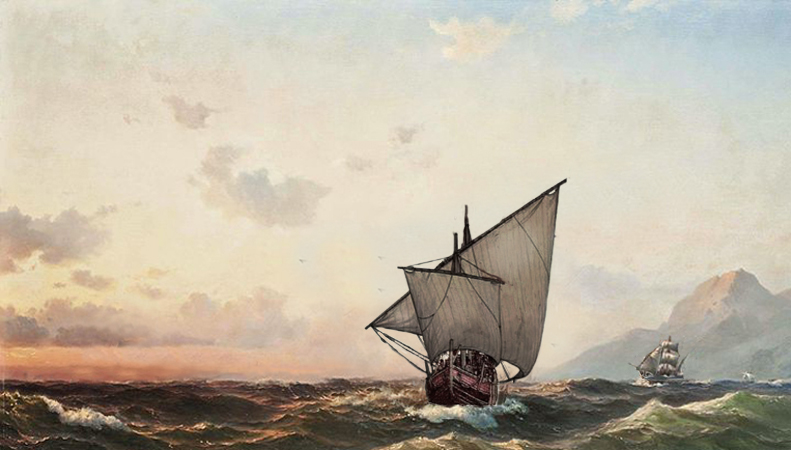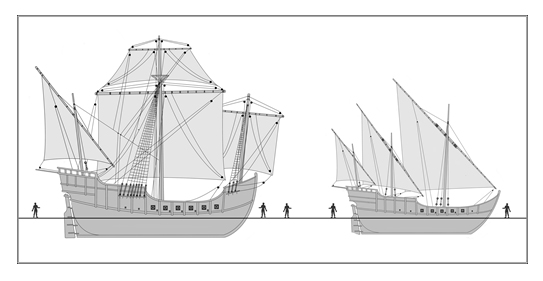Of the four main types of square-rigged ships employed by the Salé corsairs—tartanes, snows, polaccas, and caravels—one of the most common was the caravel.
Caravels were used extensively, especially by Mediterranean European nations, from the fifteenth century through to the beginning of the eighteenth. Christopher Columbus’s ships were caravels. Bartholomew Diaz, the Portuguese explorer who, in 1487, first rounded the Cape of Good Hope at the southern tip of Africa and opened the way for the Portuguese exploitation of the East, did so in a caravel. Ferdinand Magellan, whose expedition of 1519-22 was the first successful European circumnavigation of the globe, also used a caravel.
Caravels were employed so widely because they were reliable, easily maneuverable, seaworthy craft. They came in varying sizes, anywhere from about 50 to 100 feet (15 to 30 meters) in length, but most were smaller rather than larger. Traditionally, they could be rigged in two different ways, either as a caravela latina, rigged with lateen sails, or as a caravela rotunda, rigged with square sails. Eventually, the typical configuration became a compromise caravela rotunda set-up: a three-masted rig with the fore and main masts bearing square sails and the mizzen mast (the rear mast) bearing a lateen sail. (The image at the top of this post is of a hybrid caravela rotunda/latina, with a polacca in the distant background.)
Columbus’s three famous caravals—the Niña, the Pinta, and the Santa Maria—have received a lot of attention over the centuries, and there are quite detailed specs for them. A quick look at these specs can give us a clearer sense of caravel dimensions.
The Niña was about 70 feet (a little over 20 meters) long, with a beam (i.e., width) of just under 20 feet (about 6 meters) and a draft (i.e., the measurement of how deep in the water the ship sat) of just under 7 feet (about 2 meters). The Pinta was about 75 feet (a little under 23 meters) long, with a beam of a little over 16 feet (about 5 meters) and a draft of just over 7 feet (a little more than 2 meters). The Santa Maria was about 85 feet long (26 meters), with a beam of a little more than 26 feet (about 6 meters) and a draft of a little under 10 feet (about 3 meters).
Since the sandbar across the Bou Regreg River had a maximum depth of around twelve feet (3.5 meters) at high tide, caravels in this range of sizes would have all been perfectly acceptable vessels—though a ship the size of the Santa Maria would have been about the upper limit.
The illustration below shows two caravels: a caravela rotunda on the left, and a slightly smaller caravela latina on the right.
The caravela rotunda is depicted as about 70 feet (20 meters) long—the size of the Niña. The caravela latina is about 55 feet (17 meters). The illustration is to scale, showing the sizes of the two ships relative to the men who sailed them. The horizontal line represents the waterline.
When Columbus’ little flotilla left the Spanish port of Palos de la Frontera, the Pinta, and the Santa Maria were rigged as caravela rotundas. The Niña, however, was rigged as a caravela latina. Columbus stopped at the Canary Islands on his way west to have the Pinta’s ruder repaired and to have the Niña re-rigged as a rotunda. So the caravela rotunda in the illustration is pretty much what the re-rigged Niña would have looked like.
Since the limitations imposed on them by the sand bar across the entrance to their harbor forced the Salé corsairs to use smaller ships rather than larger ones, they were at a disadvantages against larger European merchant vessels or warships. For this reason, Salé corsairs rarely hunted alone: they needed the advantage of numbers.
But the smaller ships also had benefits. The most obvious was speed and agility. They had another benefit, too. They were often equipped with oars. Not only did this give the Salé corsairs an advantage against their European prey in calm conditions—both when attacking and, if necessary, escaping—it also made crossing the bar at Salé safer and easier.
There were some ship building yards in Salé, but the main source of new ships for the Salé corsairs was theft: they not only hunted for slaves and booty; they hunted for ships as well. Smallish merchant ships of this time typically carried a few cannon, but they were seldom heavily armed. The first alteration corsairs made to ships they had captured was to increase the number of cannon they carried. Gunports would be sawn into the gunwales and more cannon installed amidships. A smaller ship could only carry so many cannon, though, usually not more than 6 or 10. This basic armament would be increased by the addition of an equal or greater number of pattareroes, small caliber breech-loading swivel guns, mounted along the ship’s gunwales, that fired stone rather than lead or iron shot. The cannon mounted amidships would have been used for broadsides. The pattareroes, mounted along the railings as they were, would have had fields of fire in pretty much any direction. The result was a ship far more lethal than it had been as a merchantman.
A caravela rotunda of the size and type depicted in the illustration above would have been ideal vessel for a Salé corsair. It was small enough to be able to reliably cross the bar into the Salé harbor yet large enough to mount sufficient cannon and hold sufficient crew to be successful as a pirate vessel. Caravels are mentioned in documents from the period of Salé corsairs’ ascendancy during the first half of the seventeenth century. No lesser a figure than Jan Janszoon van Haarlem (aka Murad Reis)—who led raids to both Iceland and Ireland—sailed in one.
We should not, however, get too carried away with this ‘caravel hypothesis.’ Caravels were popular with the Salé corsairs in large part because they were common ships at the time and therefore easy to come across (and steal). Salé corsairs made extensive use of other types of smaller ships as well—pretty much anything they could get their hands on.
In these smaller ships, the Salé corsairs sailed from their harbor in packs, swarming all along the Atlantic littoral of Europe as far north and the English channel (where they specialized in preying on English fishing boats traveling to and from the rich fishing grounds off Iceland and the Grand Banks of Newfoundland).
Such packs were terrifying. For close to two decades, the Salé corsairs raided pretty much wherever they wanted, and nobody was able to stop them, for their small, agile ships were faster and more maneuverable than just about anything else on the sea.
Look, for example, at the following excerpt about a report from Plymouth, on the western tip of the English Channel coast, in August of 1625:
_________________________
The Mayor and his Brethren of Plymouth are enforced to write by the grievous complaints and daily losses which they receive through the Turks [i.e., the Salé corsairs], who have taken in one year, besides ships, 1,000 mariners. Looe, in Cornwall, has in the last ten days lost 80 mariners, and within the same time there have been 27 ships and 200 persons taken. General fear for the ships from Virginia and Newfoundland. The pirates are 26 or 27 sail strong. Sir Francis Stewart sent out 5 ships against them, but they are far better sailers than the English ships. Within 3 days the English ships left them and returned to Falmouth.
_________________________
Such was life for the English in the summer of 1625.
For those who may be interested…
The except from the report concerning the Mayor of Plymouth’s complaint comes from Calendar of State Papers Domestic: Charles I, 1625-26, entry 36: August 12, Plymouth, 1625.

Corsairs and Captives
Narratives from the Age of the Barbary Pirates
View Amazon listing
The Travels of Reverend Ólafur Egilsson
The story of the Barbary corsair raid on Iceland in 1627
View Amazon listing
